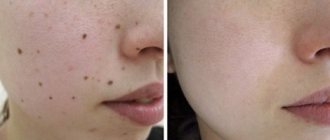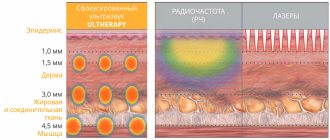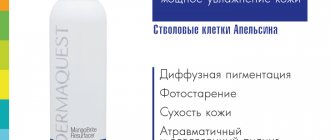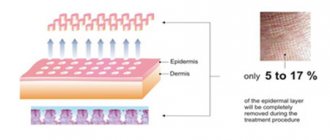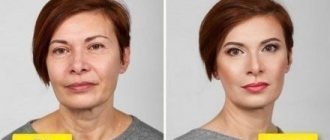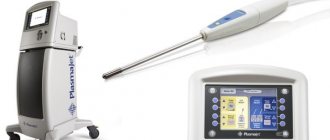Phototherapy or phototherapy is a method that involves exposing the skin to light. For procedures, special devices are used that generate radiation of certain frequencies.
The phototherapy method includes the use of various radiation sources (laser, fluorescent, dichroic lamps, light-emitting diodes). The treatment uses radiation from the ultraviolet, infrared and visible spectrum.
There are two types of phototherapy:
- broadband;
- narrowband.
In the first case, a beam of light is created that can affect a relatively large area of the skin. This method is not suitable for use in hard to reach areas. A narrow beam of light is applied to the internal surfaces of the body, areas where there are folds of the skin.
Phototherapy is carried out in courses consisting of 4-6 sessions, each of which lasts from 20 to 40 minutes. Determining the duration of one procedure and the number of sessions is within the competence of the attending physician.
Skin photorejuvenation: principle of action
Facial skin photorejuvenation is a hardware beauty procedure based on the therapeutic effect of high-intensity light on the dermal layers. The peculiarity of the method lies in selective pulsed phototherapy and the ability of light energy to be transformed into heat.
Passing through the dermis, the flow of electrons from the light beam is selectively absorbed by chromophores at a depth of 2 - 3 mm. Target tissues can be: intercellular fluid, melanin pigment, hemoglobin. Each chromophore attracts energy of a certain length. The nature of the process can be influenced by adjusting the wave range. After interacting with light particles, the target is activated and produces heat.
The photothermolysis reaction activates the activity of fibroblasts, which begin to intensify the production of new collagen. At the same time, fibroclasts gradually absorb the destroyed matrix, freeing up space for new connective tissue. As a result of heating, the walls of small vessels coagulate and the dark pigment is destroyed. As a result, defects such as rosacea, freckles, age spots disappear, the skin is tightened, and its color is normalized.
Phototherapy method
The LED facial therapy procedure is a hardware cosmetology technique based on the ability of LED radiation to activate certain acceptor enzymes (“accelerators” of biochemical reactions in cells: hemoglobin, catalase, etc.). This also helps to influence the arrangement of atoms inside the cell and its functional state. As a result, it is possible to start the process of formation of reactive oxygen species, which activate oxidative processes.
Due to light therapy, collagen and elastin fibers are produced. In this case, melanin is blocked and the genetically inherent functional abilities of the cells are restored:
- fibrous tissue is replaced with healthy collagen;
- vessels grow, concentrated in the microvasculature of the affected areas;
- Cell membranes are restored - cell growth accelerates.
How phototherapy is carried out in each specific case is determined by the cosmetologist, based on the characteristics of the patient’s skin. If necessary, a 3D facial skin diagnosis can be performed before the session.
A positive biological effect is achieved when exposed to an optimal dose of LED radiation. It should be taken into account that white skin blocks up to 95% of incoming light, and the maximum dosage is 300 J/cm2. Stronger exposure will result in cell death. Only the doctor who performs the procedure can select the correct intensity.
Equipment for skin photorejuvenation
Cosmetologists have a variety of laser equipment at their disposal to carry out the procedure. One of the best installations is the high-tech platform Palomar Star Lux 500 with an intense pulsed light (IPL) attachment - Palomar MaxG. This is the most powerful of all systems designed for anti-age therapy.
An important advantage of the installation is the safety of its use even at maximum laser power. The equipment is equipped with a contact cooling device, which reduces the risk of tissue overheating and burns, and makes the procedure absolutely painless and comfortable.
Due to the high energy of exposure, the duration of the photorejuvenation session is significantly reduced. The ability to adjust the wavelength range provides versatility of use, taking into account individual patient characteristics. The facial photorejuvenation procedure with Palomar MaxG will restore youth to the skin and eliminate aesthetic defects (spider veins, rosacea, pigmentation and others).
Types of facial skin photorejuvenation
Depending on the wavelength used, you can choose one of two rejuvenation programs:
1. Type I photo correction.
Short IPL waves provide therapy and removal of small dilated vessels and pigmentation. The result of the effect is the alignment of color and normalization of skin texture.
2. Type II photo correction.
Longer light fluxes are used to achieve a lifting effect, smoothing the relief of the dermis, improving its elasticity and firmness. Under the influence of long waves, coagulation of protein fibers (collagen, elastin) occurs, which leads to structural changes in the dermis and stimulates collagenogenesis.
How long does photorejuvenation last?
If we consider photorejuvenation in dermatology, then the duration of the result, again, depends on whether the cause of the disease at the organism level has been eliminated.
On average, if all recommendations and proper care are followed, the result of treating specific imperfections can be lifelong. 2-3 preventive procedures per year or a one-time full course are enough, everything will depend on the indications.
If photorejuvenation was performed for lifting and general improvement of skin condition, then the result lasts 12-18 months!
Stay up to date with all the news and the hottest specials.
offers - join us on INSTAGRAM! Back to blog
Indications and contraindications for photorejuvenation
The procedure can be prescribed not only for aesthetic, but also for medical reasons. Sometimes it is applicable for the treatment of acne and its consequences: photons of light have a detrimental effect on bacteria, improve blood circulation in tissues, helping to normalize metabolic processes. Conditions for which skin photorejuvenation is recommended:
- the appearance of the first degenerative changes;
- facial wrinkles;
- hyperpigmentation, freckles;
- enlarged pores;
- rosacea, vascular network, angiomas;
- sagging skin;
- rosacea;
- faded skin tone;
- uneven relief of the dermis.
Photorejuvenation of facial skin can be used not only as an independent procedure, but also as a component of complex therapy for age-related changes and aesthetic defects. In the absence of contraindications, the procedure is allowed for adolescents (from 16 years of age) with the written consent of their parents. The procedure is not hazardous to health, but there are several contraindications for its use:
- oncology;
- mental disorders;
- too tanned skin;
- abrasions, cuts in the affected area;
- pregnancy and breastfeeding;
- photodermatosis.
Acute infectious diseases and exacerbation of chronic pathologies can serve as a medical exception. The procedure increases sensitivity to ultraviolet rays, so it is not recommended during the summer.
Procedure
A month before photoirradiation, you must avoid visiting the solarium and the beach. Three days in advance - stop taking antibiotics and drugs that increase susceptibility to ultraviolet rays. Scheme of the skin photorejuvenation process:
Stage I: consultation with a dermatocosmetologist.
The doctor will examine your medical history in detail, find out the presence of contraindications and indications, and examine the dermis to determine its condition and the depth of the problem. After which he will draw up a treatment regimen, number of sessions and radiation parameters.
Stage II: procedure.
The patient is asked to wear safety glasses. The area of exposure is cleaned of dust and cosmetics. A special light-conducting composition is applied to the skin. To check the skin's reaction to radiation and adjust the device to the client's individual parameters, the doctor will conduct several test flashes. Then the cosmetologist treats the problem area with high-frequency light pulses.
Stage III: final.
During and after the manipulation, the patient feels warmth and a slight tingling sensation in the area affected by the rays. To relieve irritation, the doctor will apply a soothing regenerating cream with panthenol.
The duration of the procedure is approximately 20 minutes. The number of sessions is determined individually by the cosmetologist, which depends on the pathology and condition of the skin (from 3 to 6). Interval between phototherapy visits: 14 - 21 days.
Preparation for the procedure
Preparation for phototherapy involves a mandatory examination by a dermatologist and tests aimed at confirming the absence of contraindications. Besides this, there is another important point. Two weeks before the procedure, avoid sunbathing outdoors and going to the solarium.
This is why we do not recommend photoepilation in the summer. The skin can tan without targeted sunbathing. If you still want to carry out phototherapy in the summer, in all situations, protect your skin from exposure to direct sunlight.
Recommendations after skin photorejuvenation
After phototherapy of the skin on the body, slight hyperemia and swelling are observed, which will disappear within 1 - 2 days. To speed up the process, you can use Bepanten cream or aloe vera gel. When treating rosacea, small hematomas may appear, which can be treated with any heparin cream. When pigment spots are removed, immediately after the laser they may acquire a more intense shade, but after a few days they will disappear on their own.
After laser therapy, you must follow your doctor’s recommendations for skin care:
- Wash the areas of the dermis treated with light several times a day with cool water and neutral gel;
- apply regenerating cream for a week;
- do not sunbathe, visit steam rooms or swim in ponds for two weeks;
- Before going outside, use sun protection (SPF 50);
- Monitor the body's water balance, drink at least 1.5 liters of clean water per day.
There are two types of phototherapy:
— Broadband phototherapy. Emits a wide beam of light. Not suitable for use on hard-to-reach areas of the skin.
— Narrowband phototherapy. Emits a narrow beam of light. Makes it possible to penetrate hard-to-reach places on the body. For example, where there are skin folds.
Broadband phototherapy
Narrowband phototherapy
When talking about phototherapy, one cannot fail to mention heliotherapy. The term means sun treatment. Direct rays of the sun are used to harden the body, treat skin diseases, and extrapulmonary forms of tuberculosis.
Nowadays, visiting a solarium to get a beautiful tan has become very popular. But a solarium cannot be classified as a phototherapy procedure. Such artificial sunbathing increases the risk of melanoma by 59% and does not provide the necessary type of light. The difference is that phototherapy equipment uses UVA radiation, which is safer for the skin and has a positive effect, while beauty salons use UVB radiation for tanning, which is less safe and has a detrimental effect on human skin.
Phototherapy procedures must be prescribed by a doctor and carried out under the supervision of a specialist.
Advantage and effectiveness of the procedure
The main advantage of the procedure is its complex effect: high-intensity light not only rejuvenates, but also simultaneously eliminates aesthetic imperfections of the dermis. After the course of the program, pigment spots, acne, and vascular networks disappear, the color, elasticity and turgor of the dermis are refreshed.
The effect of treatment increases over time, as metabolism and microcirculation improve and the collagenogenesis system is normalized. The results of phototherapy last for 1.5 years or more. In addition, the secret of the high effectiveness of the procedure is:
- in the possibility of combination with other aesthetic techniques (contour plastic surgery, botulinum toxin injections, mesotherapy, etc.);
- high-tech equipment ensures guaranteed safety;
- absence of pain and discomfort;
- minimum rehabilitation period;
- cumulative effect.
The procedure does not damage the epithelial surface of the skin, is performed on an outpatient basis, and does not require hospitalization. The absence of strict age restrictions makes it possible, for medical reasons, to use the technique even for children.
The effectiveness of photorejuvenation in dermatology
For work we use the Lumenis M22 device. This device was developed by leading companies from Israel and the USA. They specialize in the production of medical equipment!
Phototherapy with the M22 device guarantees:
- Complete safety (confirmed by the FDA and the Ministry of Health of the Russian Federation)
- Noticeable results after the first procedure
- No addiction
- Long-lasting effect (completing the full course allows you to forget about skin problems for a long time. The result will be prolonged; of course, the cause of their occurrence was treated in parallel)
- Painless
- Lack of rehabilitation
- Comfortable treatment conditions (there is no need to change your usual rhythm of life, the procedure can be done even during a break at work)

